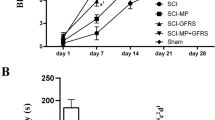Abstract.
Objective. This study examines the effects of agents purported to improve recovery following spinal cord trauma, methylprednisolone sodium succinate, dextromethorphan, and the combination of both, on the post-traumatic alterations of membrane lipid metabolism. Methods. After sparing ten rats for a control group (G1) and performing T3–T6 laminectomies in 150 rats, spinal cord injuries were accomplished in 120 of 150 Wistar rats with an aneurysmal clip compression at the level of T4-5 for 30 sec. Hence the G2 group (n 30) included the "only laminectomy/sham" group. The 120 injured animals were subdivided into four equal groups (n 30 each). Group G3 underwent no therapy, G4 methylprednisolone (MP), G5 dextromethorphan (DM), and G6 MP+DM therapies. Groups G2–G6 were killed ten by ten at 10 min, 30 min, and 120 min after the operation. We measured tissue (MDA) and blood malonyldialdehyde (MDAb), (a product of lipid peroxidation) levels as an indicator of oxidative damage by thiobarbituric acid method and activity levels of antioxidant enzymes superoxide dismutase and glutathione peroxidase in erythrocytes. Intergroup and intragroup results were compared statistically. Results. Methylprednisolone was able to keep the levels for all parameters close to baseline except for 30-min MDA, MDAb, and SOD values. But their results were all different from those of G3. Dextromethorphan was successful in this respect at 30-min GSH-Px and 120-min SOD and GSH-Px, and all values were also different from G3 values except for 10-min MDA, SOD, and GSH-Px. Combined therapy was not able to keep levels close to baseline for all parameters, but they were different from G3's except for the GSH-Px values. Methylprednisolone values displayed minimal alterations according to baseline at 120 min. Dextromethorphan was relatively unsuccessful at 10 min. Combined therapy did not show benefit superior to MP/DM single therapies.
Similar content being viewed by others
Author information
Authors and Affiliations
Additional information
Electronic Publication
Rights and permissions
About this article
Cite this article
Topsakal, C., Erol, F.S., Ozveren, F.M. et al. Effects of methylprednisolone and dextromethorphan on lipid peroxidation in an experimental model of spinal cord injury. Neurosurg Rev 25, 258–266 (2002). https://doi.org/10.1007/s101430100183
Received:
Accepted:
Published:
Issue Date:
DOI: https://doi.org/10.1007/s101430100183




